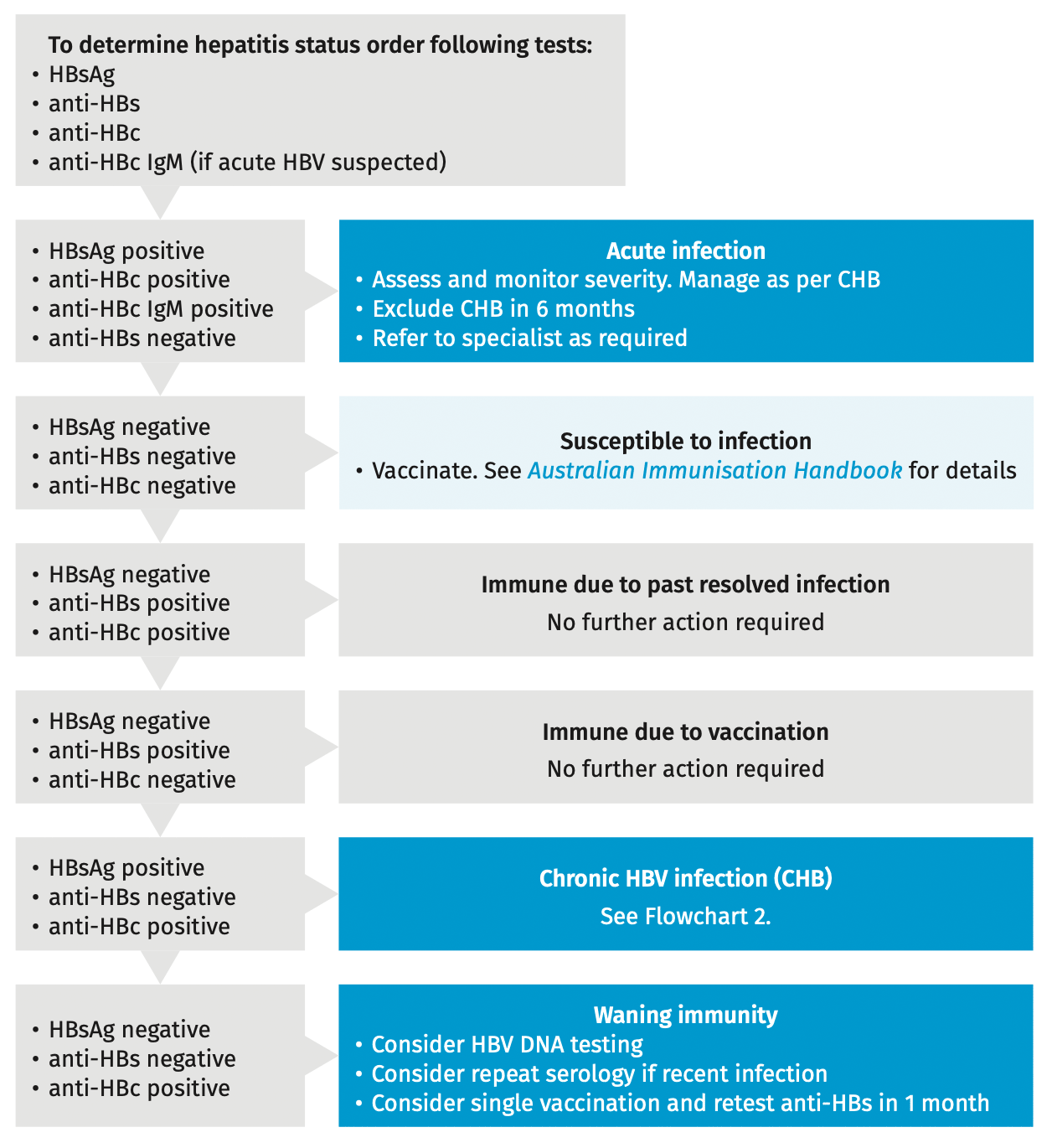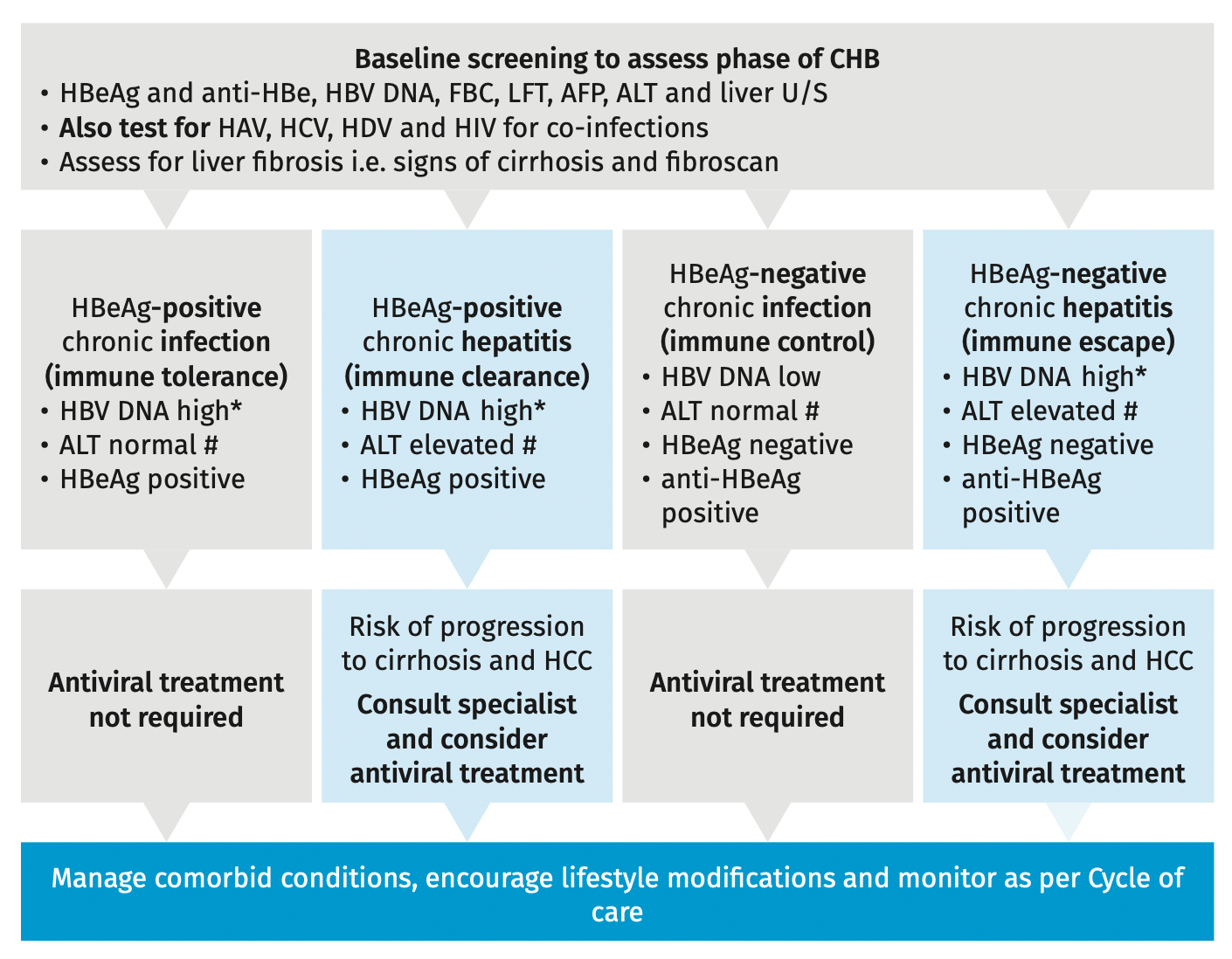High risk groups 1,2
- Aboriginal and Torres Strait Islander people
- People born in Central America, Africa, Eastern Europe, Russia, Middle East, South East Asia, the Indian subcontinent or China (CALD back grounds)
- Children born to mothers who have hepatitis B (HBV)
- Partners or household and intimate contacts of people with acute or chronic hepatitis B (CHB) infection
- Injectable drug users
- People who had tattoos or body piercings performed in unsterile conditions
- People in, or previously in, custodial settings
- People with HIV or hepatitis C
- Patients undergoing dialysis, chemotherapy or immunosuppressive therapy
- Sex workers or men who have sex with men
- Health professionals who perform exposure-prone procedures
- People with liver disease or elevated alanine transaminase (ALT) / alpha fetoprotein (AFP) of unknown aetiology
Considerations in pregnancy 2,3,4,5
- Screen all women for HBV as part of routine antenatal care. See the Primary Clinical Care Manual
- Treat HBV early in pregnancy in discussion with a specialist
- Perform HBeAg and HBV DNA to determine risk of transmission to infant
- Infants born to women who are HBsAg positive must be:
- given hepatitis B immunoglobulin (HBIG) and first dose of monovalent hepatitis B vaccine within 12 hours of birth
- tested for HBsAg and Anti-HBs at 9–12 months of age; > 3 months after completing primary hep B vaccinations
- followed-up by a paediatrician
Referral
- Refer to MO/NP and seek specialist advice for those with:
- severe exacerbation (or acute HBV)
- co-infection with HIV, HCV or HDV
- pregnant
- immunosuppressed
- hepatocellular carcinoma (HCC)
- previous treatment with a different hepatitis B medication
- cirrhosis is present or is likely
1. What is hepatitis B? 1,2,5
- A highly infectious virus that damages the liver leading to:
- abdominal pain
- dark urine
- fever
- joint pain
- loss of appetite
- nausea and vomiting
- weakness and fatigue
- jaundice of eyes and skin
- CHB (often asymptomatic)
- HCC
- The virus is transmitted by blood and body fluids from:
- mother to infant at birth
- sexual contact
- contaminated intravenous injecting equipment
- close household contact e.g. sharing toothbrushes or razors
- person to person transmission by contact with open sores or wounds
- CHB is highest amongst Aboriginal and Torres Strait Islander people (11%) and those from CALD backgrounds (61%), mostly acquired at birth or in early childhood
- Acquiring HBV as a neonate or child carries a higher risk of developing CHB (90% and 30% respectively), than if acquired as an adult (< 10%)
- Antiretroviral treatment is available
- Acute HBV is less commonly seen than CHB infections
2. Diagnosis of hepatitis B 2,3,5
- See Flowchart 1.
- Acute hepatitis B
- Confirmed by testing for anti-HBc IgM if suspected through recent risk or presentation
- Chronic hepatitis B (CHB) 2
- Is identified by venous blood serology for HBsAg, anti-HBs and anti-HBc (triple test) to determine:
- susceptibility
- immunity through vaccination or past infection
- current infection (acute or chronic)
- All high risk groups (above) should be considered for testing or if there is suspicion of an acute HBV infection through recent risk or presentation
- If CHB confirmed see Flowchart 2. to determine phase of virus and treatment
- Acute hepatitis B
Flowchart 1. Determining hepatitis B status 2,3

Flowchart 2. Assessment of CHB to determine pharmacological treatment 2–5
- *HBV DNA level is considered high if:
- > 2,000 IU/ml (104 copies/ml) in people who are hepBeAg -ve or
- > 20,000 IU/ml (105 copies/ml) in people who are hepBeAg +ve
- # elevated ALT is > 19 IU/L women and > 30 IU/L men and a review fails to identify other causes of liver dysfunction (medicines, fatty liver, alcohol)
- Patients with CHB being considered for immunosuppressive treatment or with symptoms of chronic liver disease require specialist review
3. Management of hepatitis B 2,4,5
- Managing acute HBV is the same as CHB, except patients are monitored to see if the virus clears, or virus is acquired (10% of adults)
- The goals of managing people living with hepatitis B infection is to improve quality of life and survival by:
- being adequately informed and counselled
- linking to timely care and treatment
- preventing ongoing transmission
- regularly monitoring serology
- reducing risk of progression to cirrhosis or HCC
- identifying and addressing comorbidities:
- Overweight and obesity (adult)
- Diabetes
- Hypertension
- Dyslipidaemia
- Support patient self-management 1,3
- Discuss HBV and:
- how it progresses
- how adherence to treatment can improve liver function
- provide support service details and material. See Resource 1.
- Avoiding alcohol and kava use. See Alcohol reduction
- Advocate safe Sexual and reproductive health and harm minimisation for injecting drug users to avoid HIV or hepatitis C co-infection
- Encourage the patient to identify barriers to adequate lifestyle modification and medical adherence and create goals to overcome those barriers. See Engaging our patients
- Discuss HBV and:
- Social-emotional support
- See Social-emotional wellbeing
- Alcohol and tobacco use 5
- Heavy alcohol consumption, smoking tobacco and HBsAg positivity are independently associated with increased risk of mortality from HCC
- Alcohol can cause rapid liver disease progression and reduced HBV clearance
- Those with HBV should cease drinking alcohol. See Alcohol reduction
- Smoking can cause alterations to antiviral immunity and enhanced viral replication leading to advanced hepatic disease states
- Smoking cessation can normalise liver enzymes
- Reduce the risk of developing complications 1
- People with active HBV can be effectively treated with antiviral agents to reduce the risk of long term liver damage. See 4. Medicines
- Provide ongoing monitoring as per 5. Cycle of care
- Vaccinate for hepatitis A and other vaccine preventable diseases
- Minimise risk of spreading the virus 1–5
- Test regular sexual partners and close family and household members for HBV and offer vaccination if there is:
- no evidence of having received 3 doses of HBV vaccine and
- no evidence of prior infection
- Use condoms to protect sexual contacts. See Sexual and reproductive health
- Avoid sharing toothbrushes or razors and cover wounds or cuts
- Clean up spilt blood with gloves and bleach
- Test regular sexual partners and close family and household members for HBV and offer vaccination if there is:
- Liver cancer (HCC) surveillance 4–6
- Up to 25% of untreated patients with CHB will die as a result of cirrhosis or HCC
- Assess the patient for HCC surveillance eligibility if they:
- have cirrhosis or
- are at increased risk of HCC without cirrhosis:
- Aboriginal and Torres Strait Islander > 50 years
- Māori and Pacific Islander men > 40 years or women > 50 years
- Asian men > 40 years or women > 50 years
- Sub-Saharan African > 20 years
- observed HBsAg loss i.e. at least two consecutive negative HBsAg results and at least one negative HBsAg result ≥1 week after treatment discontinuation
- coinfected with hepatitis D
- a family history of HCC (first-degree relative)
- and have been actively modifying their risk factors and adhering to treatment:
- smoking cessation
- alcohol cessation
- weight loss
- diabetes management
- antiviral therapy
- and understand surveillance involves 6 monthly ultrasounds, AFP blood tests and may include liver biopsies
- Refer to specialist if the patient is eligible for HCC surveillance
- Monitoring
- Monitor CHB serology as per 5. Cycle of care while managing comorbid conditions
- Refer patient to MO/NP if monitoring detects:
- evidence of chronic liver disease
- suspicion of immunosuppression
- pregnancy
- < 16 years of age
- possible HCC
4. Medicines for hepatitis B 4,5
- Antivirals are prescribed by a specialist in those with:
- immune clearance. See Flowchart 2.
- immune escape. See Flowchart 2.
- cirrhosis and any detectable HBV DNA, regardless of ALT levels
- Entecavir or tenofovir are the antivirals of choice
- Interferon-based treatment is contraindicated in decompensated cirrhosis
- Pregnant women with high viral load (> 200,000 or 5.3 log10 IU/mL) should be offered tenofovir from the 28th week of pregnancy to reduce the risk of perinatal transmission of hepatitis B
- Adherence to antivirals is crucial to avoid the risk of a liver flare-up
- Consider ceasing oral antiviral therapy in those without cirrhosis following HBeAg seroconversion or sustained HBsAg loss. Continue to monitor
Table 1. Medicines for chronic hepatitis B 5,6 |
|---|
Entecavir and tenofovir
|
|
Peginterferon alfa-2a (interferon)
|
|
5. Cycle of care
Table 1. Cycle of care summary for CHB | |||
|---|---|---|---|
Action | See Flowchart 2. | ||
HBeAg-positive chronic infection (immune tolerance) | HBeAg-negative chronic infection(immune control) | HBeAg-positive chronic hepatitis OR HBeAg-negative chronic hepatitis (immune clearance, immune escape) | |
Baseline observations | Dx | Dx | Dx |
Lifestyle modification | Dx and at each encounter | ||
Hep B vaccination | Check immune status of sexual and household contacts and offer | ||
Hep A, C, D and HIV serology | Dx to check for co-infection. Vaccinate if susceptible to hep A and discuss transmission and prevention of BBVs | ||
LFT, ALT | 6 mthly | 6 mthly | 3 mthly for 12/12 then 6 mthly |
HBV DNA | 12 mthly | 12 mthly | 3 mthly for 12/12 then 6 mthly |
HBeAg and anti-HBe | 6 mthly | - | 6–12 mthly if HBeAg positive at baseline |
HBsAg and anti-HBs | - | - | 12 mthly if HBV DNA undetectable |
Fibroscan or liver u/s | 12 mthly | 12 mthly | 6 mthly |
Serum phosphate and eGFR if on tenofovir disoproxil fumarate (TDF) | - | - | 3 mthly for 12/12 then 6 mthly |
FBC, INR | - | - | 3 mthly for 12/12 then 6 mthly if cirrhotic |
HCC surveillance | As per specialist advice. See 3.6 Liver cancer (HCC) surveillance | ||
Influenza, pneumococcal and COVID-19 vaccines | Recommended. See the Australian Immunisation Handbook for schedule | ||
MO/NP review | Dx and 12 mthly | Dx and 3 mthly | Dx and 3 mthly |
Specialist review | As required | ||
6. References
- All Chronic Conditions Manual references are available via the downloadable References PDF